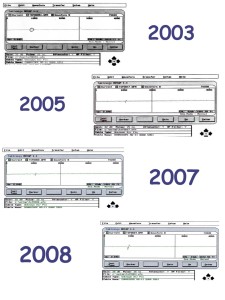We recently had a client with many, many Modicon remote I/O and Modbus plus networks installed and in use in their plant, pose this question. The short answer is usually every one to two years or if they are having any errors. The longer answer is that it depends upon what environment that these networks are installed in within the plant. A system installed within a climate controlled environment is much less likely to require as frequent certification as a similar system installed in a hot, moist or corrosive environment. A fact that is often overlooked, it that cables, all cables, have a service life. Extreme environmental conditions will only subtract from that service life. Periodic testing/certification allows the user to monitor the cable (and the systems’ components) for any degradation leading to future failures.
Following is an example of periodic certifications showing a progressive cable problem. This particular network was checked every two years during a regularly scheduled plant shutdown. An issue was noted upon a section of coaxial cable. It was indicated upon the report and suggested to replace that section of cable, even though it was not causing any issues at this time (2003). The next shutdown, two years later (2005), the same anomaly was noted, although it had increased in size (amplitude). Again it was noted on the report and again the suggestion to replace that cable was made. Another two years passed (2007) and the network showed the cable anomaly had again increased in size. Once again it was not causing any issues with the system, but was strongly suggested that this section of cable be replaced. About a year later (2008), we received an emergency call from this client. The entire plants’ operation had come to a halt as this system had gone down. The clients maintenance people could not correct the problem. We inquired as to whether the suspected cable section had been replaced. It had not. The client requested that we come on-site to rectify the problem. Once on-site, a quick look with the TDR showed that the same anomaly had increased in size dramatically, and was now preventing any communication from occurring on the cable. We substituted a temporary section of cable for the defective piece by routing a cable through several buildings, under a road and along the ground between the two points. The system came up immediately. Several days later, as the defective cable was pulled out and a new section permanently installed, the client was puzzled as to what was actually wrong with the cable. A visual examination by the client showed nothing amiss. The client sent the defective cable to Delta and we located the anomaly and issued a report. A description of this cables’ issue can be viewed on another of our blogs/newsletters at http://www.deltaautomation.com/dnlds/newsletter%20winter%202008.pdf Page 2, the Tech Tip, titled “Testing for corroded coaxial cables.”
Below are the TDR graphs from the network certification reports performed over several years. As you can see, the anomaly gradually increases in size until it causes a complete system failure.

